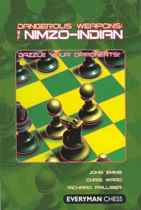Dangerous Weapons — The Nimzo-Indian
Jonathan Emms, Richard Palliser

Its hard to believe that a new type of opening book can be written, but with Dangerous Weapons: The Sicilian and Dangerous Weapons: The Nimzo-Indian, both authored by GM Jonathan Emms and IM Richard Palliser (with GM Chris Ward assisting on the latter) Everyman Chess (www.everymanchess.com) looks to have a winning series straight out of the gate.
Both books feature a series of articles that can be interesting for those who play or face the Sicilian and Nimzo-Indian. Some of them are on main lines while others are on sidelines the authors believe deserve a second look. The emphasis is on taking the opponent to unfamiliar positions with sharp unbalancing play. There is a great deal of original analysis throughout both books but the authors dont have any clear bias.
Dangerous Weapons: The Sicilian could just as easy be called Dangerous Weapons: The Open Sicilian as almost but not all 14 chapters have White opening 1.e4, 2.Nf3 and 3.d4 (the sole exception is the OKelly chapter 1.e4 c5 2.Nf3 a6 where alternatives to 3.d4 are looked at closely).They include chapters principally from the White perspective (for example 1.e4 c5 2.Nf3 d6 3.d4 cxd4 4.Nxd4 Nf6 5.f3, 6.Nde2 versus the Sveshnikov, 5.f4 versus the Kan/Paulsen and 6.Qf3 versus the Najdorf) and ones from Black’s side (the aforementioned OKelly, 6…e5 versus the Sozin, the Kolencs-Goletiani Kan/Paulsen 1.e4 c5 2.Nf3 e6 3.d4 cxd4 4.Nxd4 a6 5.Nc3 Qc7 6.Bd3 Bd6!? and the Lowenthal (2…Nc6, 4…e5 and 5…a6). The latter is particularly thorough with 43 pages covering all of Whites choices after 1.e4 c5 2.Nf3 Nc6 3.d4 cxd4 4.Nxd4 e5 5.Nb5 a6 6.Nd6+ Bxd6 7.Qxd6 Qf6.
I always thought the OKelly was a nice try that fell short when White failed to play 3.d4, but Emms provides evidence to the contrary. For example after 3.c3 d5 4.exd5 Qxd5 5.d4 Nf6 6.Be2 e6 7.0-0 cxd4 8.cxd4 Nc6 9.Nc3 Qd8 10.Be3 planning on meeting 10…Be7 with 11.Ne5! Black can take advantage of the flexibility rendered by 2…a6 and play 10…Bd6! (because White has already committed his Bishop to e3). If you dont like 4…Qxd5 in this position how about 4…Nf6!? Perhaps its not 100 percent sound, and Emms isnt selling it with a warranty, but it is plenty tricky and there is lots of original analysis.
If you play the Open Sicilian or are looking for a new variation to take up as Black — perhaps even as a surprise or back-up weapon, then Dangerous Weapons: The Sicilian is for you.
Recommended.
Dangerous Weapons: The Nimzo-Indian is similar to the volume on the Sicilian except that it is written more from Blacks point of view. Almost 100 pages on various ways of handling 4.Qc2 should provide plenty of interesting reading for those who meet the Nimzo this way, and chapters on 1.d4 Nf6 2.c4 e6 3.Nc3 Bb4 4.Nf3 c5 5.d5!? and 4…b6 5.Bg5 Bb7 6.Nd2 h6 7.Bh4 c5 8.d5!? provide another partial opening repertoire. Still the emphasis is primarily the Black side of the Nimzo and one theme that crops is when ever possible trying to head for a Nimzo-Dutch hybrid with an early …Ne4 and …f5. This shows up after 4.e3 and 4.Nf3 (4…Ne4!?). If you adopt these two lines the rest of the book comes pretty close to providing a complete repertoire. That said I think the book probably works better for previous Nimzo users who are looking for an infusion of new ideas and analysis to fill in the gaps and provide some inspiration.
Recommended.
